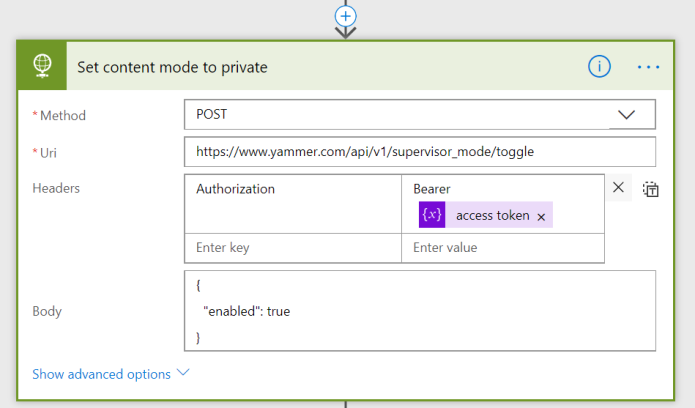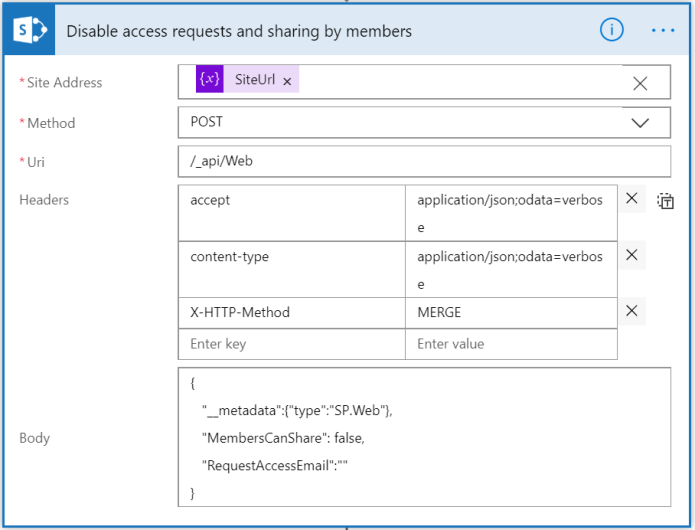I’m currently helping a customer to rollout Yammer to ~4,000 employees across the world. The goal is to improve knowledge sharing and communication across locations, projects and departments. Microsoft Teams is also on the roadmap, and will be rolled out later this year.

We have tailored Microsoft’s “Where to start the conversation” message and our strategy is to use Yammer for internal communication only and use public groups to better address the vision about breaking down the silos. We even defined a KPI for number of private vs public Yammer groups.
Unfortunately, it is currently not possible in Yammer to proactively enforce the policies to:
- prevent who can create groups
- prevent creation of external groups
- prevent creation of private or public groups
We decided instead to reactively govern Yammer groups using Microsoft Flow and Yammer REST APIs. Now, there is a built-in Yammer connector in Flow, but the current functionality doesn’t support our requirements. We decided to build two flows, one for governing external groups and one for private groups. Each flow runs on a daily schedule.

The flow that governs private groups, emails the private group owners with a message that they need to open or delete their group. The screenshot below shows the effect on private groups after one week of running the flow.

The flow that governs external groups, emails the external group creators and delete their group.
Account for running the flows and accessing the Yammer APIs
- The account can be a cloud only account and doesn’t need any admin roles in Office 365.
- The account must be licensed for Yammer to use the APIs, for Outlook to send emails and SharePoint for logging purposes.
- The account must be a Verified admin in Yammer to delete or get details about groups the account isn’t member of.
Register a Yammer application and create an access token
- Goto https://www.yammer.com/client_applications and sign-in with the verified admin account.
- Click “Register New App”, fill in the required fields and click “Continue”. You only need to think about the Redirect URI, as you’re mainly interested in the generated client id and secret in addition.

-
Next go to https://www.yammer.com/oauth2/authorize?client_id=YOUR_CLIENT_ID_HERE&response_type=code&redirect_uri=https://localhost
- Click “Allow” to grant the app to access Yammer on the account’s behalf.

- Now, extract the code appended to your redirect URI from the browser’s address bar.
https://localhost/?code=CODE_TO_EXTRACT_HERE
- Next go to https://www.yammer.com/oauth2/access_token.json?client_id=YOUR_CLIENT_ID&client_secret=YOUR_CLIENT_SECRET&code=CODE_YOU_EXTRACTED_FROM_REDIRECT_URI
- Extract the access_token from the JSON in the response from above and send it in the Authorization header when invoking the REST endpoints.
{
“access_token”:{
…,
“token”:”THIS_IS_THE_ACCESS_TOKEN”,
…,
“expires_at”:null
},
“user”:{…},
“network”:{…}
}
Yammer API endpoints used in the flows
These are the REST endpoints we used in our flows.
- Get the Yammer groups, 50 per page
GET https://www.yammer.com/api/v1/groups.json?page={page}
- Get group creator
GET https://www.yammer.com/api/v1/users/{creator_id}.json
- Get group admins
GET https://www.yammer.com/api/v1/groups/{id}/members.json
- Delete group
DELETE https://www.yammer.com/api/v1/groups/{id}
- Set content mode
POST https://www.yammer.com/api/v1/supervisor_mode/toggle
You can access documentation about the REST API on Yammer Developer Center
https://developer.yammer.com/docs
Implementing the flows
The flows both starts with a scheduled trigger and a set of actions for variable initialization

Content mode is then set to private for access to groups the account is not member of.

The Yammer groups endpoint doesn’t support the HTTP connectors built-in pagination, so a Do Until loop is used to handle pagination of the groups that are returned 50 at-a-time.

Then we union the groups and paginate before moving on to parsing and filtering the groups.

This is how we filter for private groups

And this is how we filter for external groups. Be aware that external groups are also private (just in case you want to process both private and external groups in same Flow)!

We process the private groups in a Apply-to-each loop, get the members of the group and filter for group admins.

How we filter for group admins

Next we send an email to all private group administrators in a Apply-to-each loop.

The final steps of the flow sets the private content mode back to default and logs the number of private and total groups to a SharePoint list. The numbers are needed for the KPI measures.

For each external group, we get the creator, send the person an email and delete the group.

Measuring success
We believe that using Microsoft Flow will help us reach our business goals. We have defined a strategy and success plan for knowledge sharing, and defined KPIs for measuring progress and realization of these goals.

I have shown you how to manage Yammer groups using Microsoft Flow and Yammer REST APIs. Don’t stop here! Start exploring other opportunities and use your favorite REST API to manage what’s important for you and your business.
Happy flowing!
























